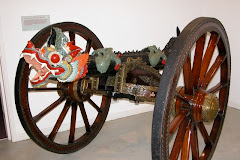The earliest ammunition types were the war arrow, a hail of large stones and the stone cannonball. It would be difficult to say which came first, though the war arrow is the munition depicted in the earliest known image of a gun.

There seems to be no record of them being used in war, but they remained in the inventory of the Tower of London for some 200 years. They would have had to have the warhead and the fins of the same diameter as the bore of the gun and be loaded with a tampion or wad between the tail and the propellant to provide the seal that allowed the propellant to develop its pressure. Their disadvantage was that they were only effective against men or cavalry in the open and did not have the 'hitting power' of a cannonball in siege warfare.
The hail of stones was a weapon of the 'perrier' mortar and was useful in sieges for attacking people in the open, thinking themselves protected by city or fortress walls. The stone cannonball was really only a replica of the projectiles hurled by the catapult and trebuchet, but in guns it had to be cut more accurately if it was to do the job of sealing the propellant gases long enough for them to build up pressure, and of course, not to damage the gun.
When guns began to be cast in bronze, there were occasional examples of bronze cannonballs, but the more usual early shot from these guns was the stone ball with a covering of lead. The lead gave it the weight to make it carry further and yet avoided the problems in making it entirely of lead and too heavy. Too much weight produces greater resistance in the bore and could result in bursting the gun.
Once the technique required for melting iron had been discovered, guns were cast in this material, producing stronger guns that could cope with heavier ammunition and larger propelling charges. Cannonballs began to be made of iron, usually by the same people who were casting iron guns because they had both the material and the requisite skills.
Throughout the early period and right up to the end of the smoothbore period in the middle of the 19th Century, incendiary projectiles were much in evidence. They were used in siege warfare to set fire to the wooden constructions and thatched roofs found inside cities and castles. Based on a simple internal framework, the materials used to construct the fireball varied over the years, but they must have been a frightening sight for the defenders as they flew across the sky, flames burning brightly and trailing smoke.

The invention of the hollow shell led to the development of other types of ammunition. Filled with gunpowder and detonated by a long fuze, shells were very effective in causing both damage and casualties. The blast effect, with its noise and the flying fragments of the burst shell, was a new terror both in siege warfare and on the battlefield. When Henry Shrapnel packed a shell with musket balls and burst the shell above the heads of the enemy, the rain of lead balls was, in effect, a longer range version of 'canister', the dreaded hail of lead fired at close range against infantry and cavalry.
And last, the extraordinary invention of light-producing flares to illuminate the battlefield or the breach in a siege wall, including during the 19th Century a flare packed with a parachute that would take longer to fall, making it more useful.




No comments:
Post a Comment